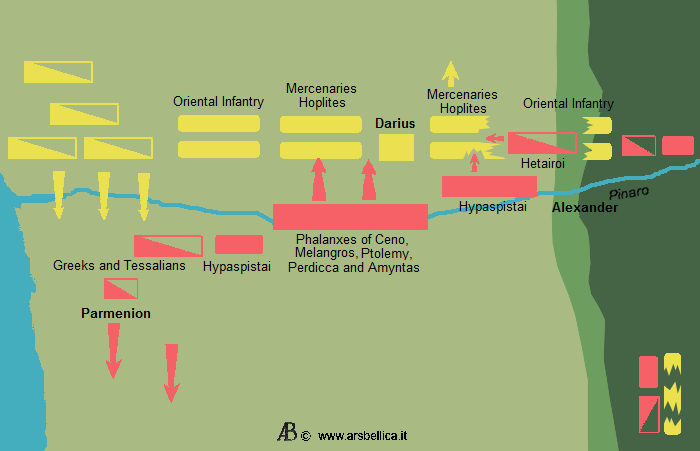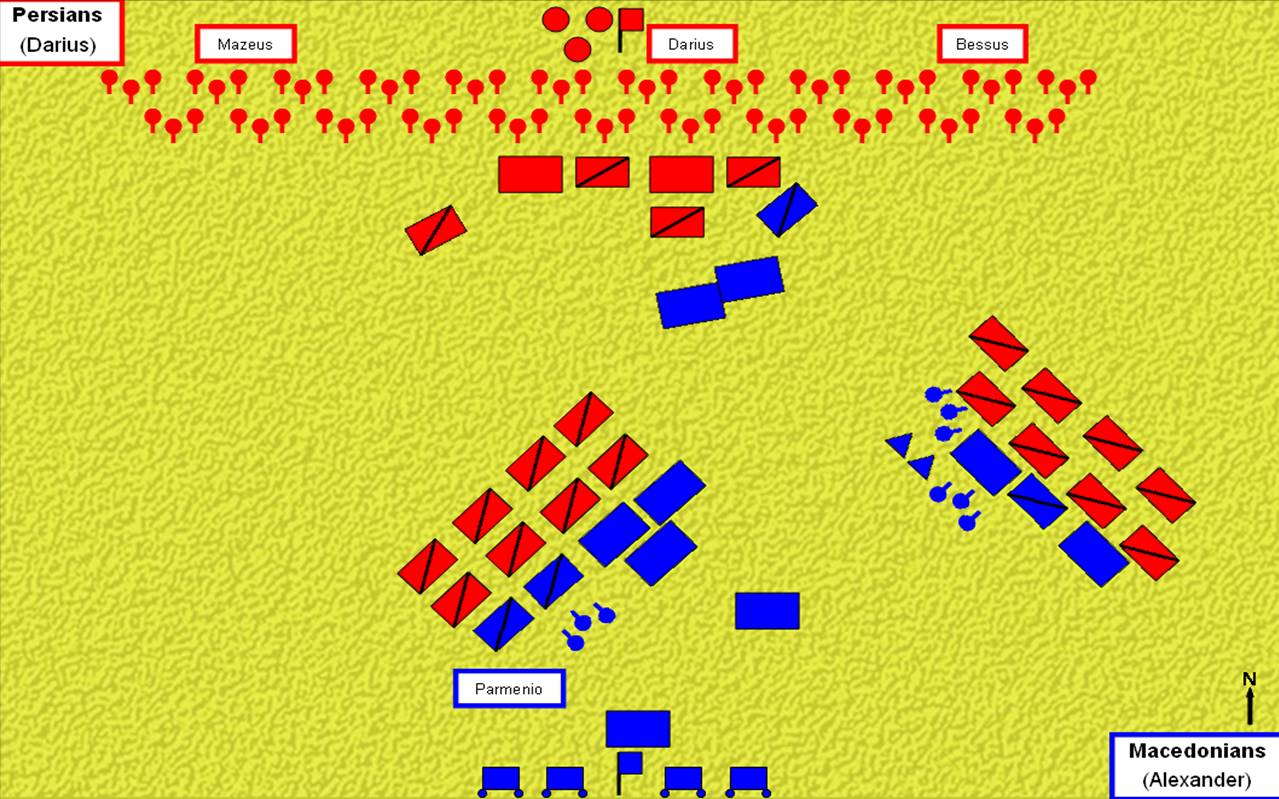AS: Aice Classical Studies Big 3 Battle & Sieges of Tyre: Flash-Cards
1/6
Earn XP
Description and Tags
Name | Mastery | Learn | Test | Matching | Spaced |
|---|
No study sessions yet.
7 Terms

Battle Of Granicus
334 Bc
First Major Battle between ATG n Persian Empire
It was the first major victory for Alexander the Great and began the conquest of the Persian Empire
the Persian army was massacred after this battle and led to the Persian army to retreat.
The Persians knew very little of him and underestimated his power, hence why Darius sent his general, Arsames, to fight instead of falling back like he was advised to do by Greek mercenary Memnon of Rhodes.

Battle of Issus
333 BCE
The Battle of Issus was another major battle in the persian conquest
Alexander fought King Darius III
Fought on the banks of the Pinarus River
Despite being outnumbered, Alexander managed to run the right wing and outflank the barbarians
Alexander received a sword wound in his thigh
The Persians were defeated, and King Darius fled
110,000 of Darius’ men were killed
Alexander took Darius’ wife and children, as well as captured his bow and chariot o When the Persians fled, Alexander proceeded to loot Darius’ camp

Gaugamela
331 BC
Prior to the battle, Darius offered Alexander a lot of things in return for peace but Alexander refused as he believed his destiny was to rule the world.
Alexander was told a prophecy before the battle stating that a “battle would be fought and Alexander would win it” in the month of October,He won the battle in the month of October.
Darius cleared the battlefield before fighting.
Parmanus told ATG to attack them at night but alex said “I will not steal a victory”
Advance with the main unit or follow Paremnio’s advice to send out a reconnaissance team to check the ground for traps.
After scouting, Alexander made camp and refused Paremnio’s advice to attack at night.
Darius expected a night attack so his army didn’t get sleep. (Gave alex an advantage)
Battle which completed Alexander’s quest in conquering the Persian Empire.
It was an incredible victory for Alexander as his army was outnumbered
Persian Army had Elphants and
Sogdian Rock
327 BC
Sodian Rock was thought to be unconquerable with their high defense, a large quantity of food and supplies (enough to last a siege for 2 years) and its location as steep cliffs surrounded it.
The Natives insult ATG which made him mad and upset
Alexander demanded Ariamazes to surrender, which was refused.
The position of Ariamazes' army was on the walls facing Alexander's Army, but he left the cliff on his rear unguarded. Alexander believed that Ariamazes would not expect the army to survive and climb the cliffs, so he took action.
He ordered 300 volunteers who had climbing experience guaranteeing a prize, including a reward of 12 talents to the first who reached the top 11 who reached 2nd and 10 for who reached the top 3rd.
According to Curtius, Alexander told his men “Nature has placed nothing so high that courage cannot overcome it. By striving to achieve what others have not dared, we have Asia under our control."
The climb had to be done overnight so the men would not be spotted by Ariamaze and the winter conditions increased the risk of falling.
The volunteers were supplied with iron tent pegs and ropes.
Around 30 of their men were lost in the ascent
The signal that the army would send would be waving white sheets once they reached the summit.
Once the army sent the signal at around dawn Alexander moved his army forward asking Arimazes to surrender once again which was refused until Alexander said that he indeed did have winged men .
The fortress surrendered as they couldn't tell how many men were waiting at the summit and they had caught them by surprise.
The army marched in and executed and captured many of the Sogdian nobles.
Gaza
October, 332 BC
Following the previous Siege of Tyre in 332 BCE, Alexander sought to conquer Gaza, “the most important city in Syria.”
He needed Gaza because it prevented him from entering Egypt
Gaza was bounded on all sides by 60-foot-high walls. The walls functioned as a line of defense for the surrounding area
As Alexander led up the phalanx of the Macedonians from all sides, he threw down the weak part of the wall, and battered another large portion of it with his engines
Alexander learned from trial and error because of his unsuccessful attempts to use the same artillery during the Siege of Tyre which allowed him to conquer Gaza faster
Alexander examined the most logical way for him and his armed men to enter
He chose the southern wall as an entrance because it appeared to have the weakest structure overall
Ended up submitting his entire army into battle
Alexander was injured during the Siege of Gaza
The Siege of Gaza was yet another successful conquest of Alexander’s. The Macedonians acquired access to Egypt. After Gaza was captured, all the men were executed while the women and children were sold into slavery
Aornus
Took place in 327 BC. (during Indian campaign, a few miles west of the Indus River and north of the Buner River)
Natural stronghold blocked Alexander’s path to India
It was the last threat to his supply line (which stretched over the Hindu Kush and ended at Balkh)
Flat summit, well supplied with springs and space for growing crops (could not be starved into submission)
Local myth told that a god (Heracles) was unable to capture this rock, making it a challenge for Alexander that he wanted to complete
Natives surrendered and offered to expose the part of the rock that can be most easily accessed.
Alexander gave his officer, Ptolemy, instructions to occupy the space with a strong guard
Ptolemy occupied his position without the knowledge of the barbarians and signaled to Alexander
When he tried to advance with his army, the barbarians disputed it leaving him with nothing to do because of the state of the ground.
When the barbarians concluded that Alexander could not make an offensive move, they proceeded to attack Ptolemy.
Barbarians withdrew during the night.
Indians and Macedonians were experiencing a battle, with the Macedonians forcing a way in despite the resistance.
Alexander made his way back to the rock with the rest of the army and insisted on raising the mound.
Took a few days to organize themselves, built a 50-meter mound
The Indians desisted once they saw the mound, no longer attempting to resist
They sent a herald to alexander to surrender and propose a truce
While delaying the truce, the barbarians tried to escape from the scene
Alexander discovered their plan and allowed them to continue scattering as he gathered 700 body-guards and shield-bearing infantry to scale the rock the barbarians had abandoned
Alexander signaled the men to turn and kill as many of the retreating barbarians as possible (others leaped down into precipices due to fear of being killed)
Alexander offered a sacrifice on the rock to commemorate and then arranged a fort
Tyre
332
By 332 B.C. Tyre was a well-fortified and established island
Its inhabitants considered the territory inviolable because of its wealth in commerce and 150-foot walls.
As Alexander approached, Tyrian leaders knew they needed to be weary and somewhat cooperative with the ambitious young monarch.
Alexander conspired to enter their land by requesting to make a sacrifice at the ancient temple of the Tyrian god Melqart.
Unwilling to betray King Darius by granting Alexander access while their conflict was still brewing, the Tyrians politely declined, suggesting that he instead make his sacrifice to Hercules in an island on the opposite side of the mainland.
Alex was enraged by their refusal.
He had another dream, this time of Hercules leading him into Tyre, which he took as a good omen.
He retaliated by dispatching his heralds to the city and demanding the Tyrians to surrender or be conquered.
Tyrians killed these heralds and threw them over their city’s walls.
Realizing he would have to conquer Tyre by Siege; Alexander still had the task of convincing his men of this toilsome plan.
The plan would have to involve the soldiers going unnoticed for as long as possible so that Tyre’s strong defense would not hinder them.
While Alexander still had much working against him, the Macedonian army was strong and capable of a siege.
He began destroying remains of Old Tyre to build a 200 ft. mole, which the Tyrians soon learned of as its construction neared completion.
To defend against the Tyrian ships which fired at Macedonians making it impossible for them to finish the channel, Alex ordered the building of two siege towers armed with artillery.
Tyrians learned of this and devised a special ship to set fire to the siege towers. Its success led to Alexander’s towers up in flames, the penetration of the stockade which protected the mole, as well as the loss of all his siege engines.
Defining moment of Alexander’s campaign
Victory of Tyre led Palestine, Syria, and Egypt into Alexander’s empire